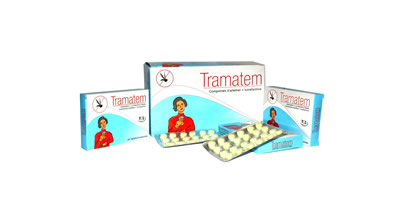
Arthemeter Ph. Int. 20 mg
Lumefantrine Ph. Int. 120 mg
Read all of this leaflet carefully before you take this medicine.
• Keep this leaflet. You many need to read it again.
• If you have further question, please ask your Pharmacist or your Doctor.
• This medicine has been prescribed for you. Do not pass it on to others. It may harm them, even if their symptoms are the same as yours.
In this leaflet:
1. What Tramatem Tablet is and what it is used for:
2. Precautions and warning before you take Tramatem Tablet
3. How to take Tramatem Tablet
4. Possible side effects.
5. Symptoms and treatment of over dosage
6. How to store Tramatem Tablets
7. Further information
1. WHAT TRAMATEM TABLET IS AND WHAT IT IS USED FOR
Tramatem Tablet is an artemisinin based anti-malaria medicine containing two (2) active drugs, namely, Arthemeter and Lumefantrine. It works by inhibition of nucleic acid and protein synthesis in the blood schizont. It also causes morphological changes to the plasmodium parasite that causes malaria infection.
2. PRECAUTIONS AND WARNING BEFORE YOU TAKE TRAMATEM TABLET
Contraindication:
• Do not take Tramatem Tablet if you are allergic or highly sensitive to Arthemeter, Lumefantrine or any of the ingredients of Tramatem Tablet.
• You have severe malaria, respiratory distress, abnormal bleeding, haemoglobinuria, hypoglycemia, electrolyte imbalance, hyperlactemia and hyperparasitemia
• If you have a family history of congenital prolongation of QTc interval or sudden death or any condition known to prolong the QTc interval.
Pregnancy and lactation:
• Pregnant women should not take Tramatem during the first trimester of pregnancy especially when other suitable and effective anti-malarials are available.
• Do not take Tramatem tablet during breast feeding.
Take special care with Tramatem Tablet:
• If you have severely impaired hepatic function or are taking hormonal contraceptive. If you have previously taken mefloquine or quinine. Close monitoring of food and ECG is respectively advised. Tramatem tablet should not be taken less than one month after the last dose of halofantrine.
Stop Taking Tramatem:
At the first sign of severe malaria (such as prostration and/or breathing difficulties, generalized convulsions, dark and/or limited urine production) and seek immediate medical attention.
Taking other Medicines:
• Please inform your Pharmacist or Doctor if you are taking or about to take any other medicine, including those obtained without a prescription.
Driving and using Machines
• Tramatem tablets may make you feel sleepy, dizzy or generally weak. If this happens to you, do not undertake tasks requiring alertness.
3. HOW TO TAKE TRAMATEM TABLET
• You should take your medicine exactly as your Doctor or Pharmacist directs you.
• The tablets should be taken whole with food or drinks rich in fat such as milk.
Dosage:
Adults and children weighing 35 kg and above, or more than 12 years should take 4 tablets of 20 mg/120 mg as a single initial dose. Again, 4 tablets after 8hours and then 4 tablets twice daily (12 hourly) for the remaining 2days. Children 12 years or less and weighing between 5 -35kg should take 1 – 3 tablets in a similar dosage regimen as the adults.
Resistance and Recrudescence:
An apparent resistance to treatment resulting mainly from multiple broods of plasmodia developing at different times in the same patient is reported in few instances (< 10 %). In case of recrudescence, a new complete treatment for 3 days is advisable.
4. POSSIBLE SIDE EFFECTS
Like all medicines, Tramatem can cause side effects, although not everybody gets them. GI adverse effects like nausea, vomiting, abdominal pain and diarrhoea have been reported so are CNS effects like headache, dizziness, clonus, somnolence and ataxia. In addition, rash, pruritus, urticaria, cough, palpitations, sleep disorder, arthralgia and myalgia have also been reported.
Possible interactions with food and drugs
Tramatem should not be taken together with grapefruit juice, and also if you are taking antibiotics such as rifampicin, macrolides, fluoroquinolones, imidazole and triazole antifungals, neuroleptic and antidepressant agents, classes 1A and III antiarrhythmics. Again, avoid use together with drugs like cisapride, antihistamines terfenadine and astemizole and CYP3A4 inducers.
5. SYMPTOMS AND TREATMENT OF OVER DOSAGE
Overdose is marked by anorexia, vomiting and CNS stimulation including seizures. Treatment of overdose consists mainly of symptomatic and supportive therapy. ECG and electrolytes should be monitored.
6. HOW TO STORE TRAMATEM TABLET
Keep your Medication out of reach and sight of children. Keep it in the original package and store below 30oc. Check the expiry date on the label and do not use if product is expired.
7. FURTHER INFORMATION
Each tablet contains 20mg of arthemeter and 120mg of lumefantrine. The other ingredients in Tramatem tablet are: Microcrystalline Cellulose, Povidone, Sodium Methylparaben, Sodium laurylsulphate, Maize Starch, Sodium starch glycolate, Talc, Magnesium Stearate, and Silicone Dioxide.
Date of publication / review: Effective June, 2014, this publication is subject to review every two years and upon receipt of new product information.


